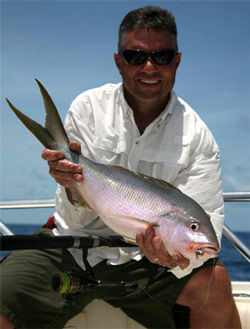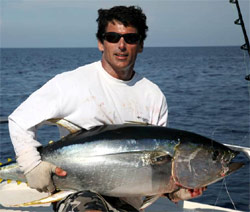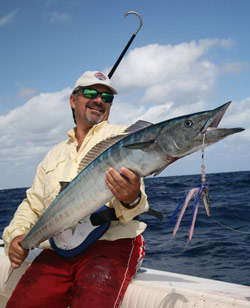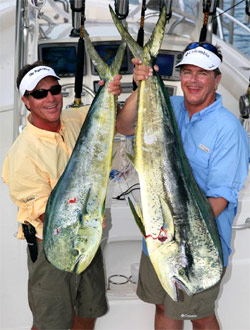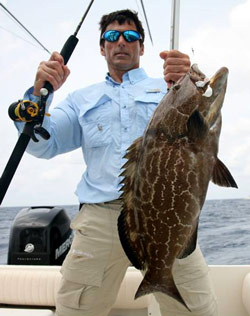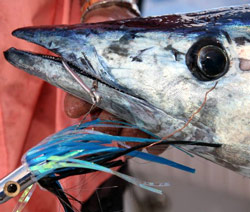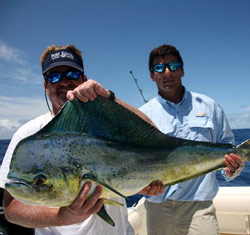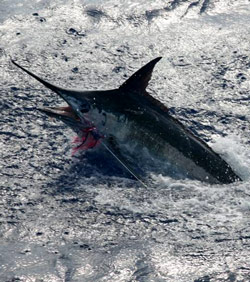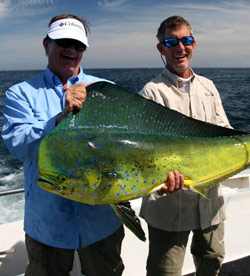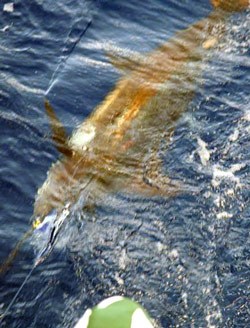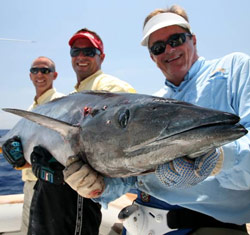.jpg)
To See A Larger Version Of Any Picture, Just Click On That Picture!
BIMINI - Arguably the most famous Bahamas fishing destination due to its proximity to South Florida (50 miles from Miami), the Biminis offer a variety of angling opportunities ranging from bonefish to blue marlin (one of the only two “grander” blue marlin was taken here in 1979). Best bet: anchoring up on the reefs and chumming for yellowtail, and dropping down for muttons and grouper during the spring. Don’t neglect freelining live baits in the slick for big kings and Cero mackerel.
CHUB CAY - Another 80 miles east/southeast of Bimini is the fabled Chub Cay Club, which is on the doorstep of the deep Tongue of the Ocean. Catch a good east to southeast blow here during the spring, and “The Pocket” turns into a virtual fish bowl of dolphin and marlin. At times, schools of quality size dolphin are so thick, you can’t get away from them. It’s an excellent spot for those who want fast action with big dolphin, and the blue marlin bite can be also be outstanding. Best bet: Let’s call this one a tie between dolphin and blue marlin.
FREEPORT, GRAND BAHAMA - Grand Bahama is a big tourist destination and one of the more heavily-populated Islands in the Bahamas. Freeport is a big cruise ship landing. However, it’s also an ideal base to chase the yellowfins that roam within Northwest Providence Channel between April and September. Chasing birds early and late in the day and then either trolling, chunking or live-chumming should score tuna between 25 and 70-pounds.
WEST END, GRAND BAHAMA – Situated on Grand Bahama’s western side, where Northwest Providence Channel meets the Gulf Stream, trollers have the options of: a.) running north and working the tight bottom contours between Memory Rock and White Sand for wahoo; b.) running farther up to the northwest tip of the Little Bahama Bank and trolling around Matanilla Shoal or Matanilla Reef for wahoo, tuna and marlin; c.) heading south for yellowfins in Northwest Providence Channel; or - d.) trolling right out front for wahoo and dolphin when there’s a strong current in tight.
TREASURE CAY/MARSH HARBOUR - Between April and early June, blue marlin are the big draw off this section of the Abacos. Fish in the 800- and 900-pound class have been taken here, and there are stories of long, unsuccessful fights with fish over 1,000-pounds. This is big marlin country. A strong second choice is dolphin, as some of the largest dolphin anywhere migrate past the Abacos during the spring. At times, dolphin in the 30- and 40-pound class won’t even raise an eye brow.
GREEN TURTLE, ABACO - A big thumbs up goes to the bonefishing surrounding the famous Green Turtle Club. Compared to many Bahamas flats-fishing destinations that harbor large schools of small bonefish, this area has big fish. Fish between six- and eight-pounds are common, and you’ll usually see a brute or two in the double-digit category during a day of stalking. Don’t neglect the offshore side here, where dolphin, marlin and tuna migrate past during the spring. Bottom-fishing is also productive on the reefs.
SANDY POINT, ABACO - Situated several miles around Abaco’s southwest tip, Sandy Point is strategically close to Hole In The Wall and some excellent bottom fishing. In addition, wahoo stack up in the rips that materialize in and around the mouth of Northeast Providence Channel. This area is also excellent for yellowfins.
KAMALAME CAY, ANDROS ISLAND - This luxury resort on Staniard Creek offers those aboard mid-size boats the opportunity to fish the Navy buoys for dolphin and yellowfin tuna during spring and summer, and also the reef line for wahoo during the winter. The big draw here is the bonefishing around Kamalame Cay and especially the Joulters at the northern tip of Andros.
ANDROS LIGHTHOUSE YACHT CLUB & MARINA, ANDROS - Located on Fresh Creek and south of Kamalame Cay, dolphin and yellowfin tuna are the tickets during spring and summer, especially around the buoys. Big kings are for the taking on the reefs, especially when drifting live baits far back in a chum slick while yellowtailing. Don’t overlook the drifting and deep-jigging opportunities for grouper, snapper and jacks over the reefs, when there’s good current and clean blue water.
HARBOUR ISLAND – Situated off Eleuthera’s northeast side, yellowfin tuna is the big draw here during spring and summer. Live-chumming with pilchards is commonly practiced over “Dutch Bar”, to rally the yellowfins. However, anglers are also catching them by chunking. Spooning and trolling will also catch some fish, if you don’t have live bait. There’s plenty of big dolphin migrating past during the spring and early summer, as well as blue marlin.
DAVIS HARBOUR, ELEUTHERA – A strategic fishing destination for mid-size boats, Davis Harbour is on Eleuthera’s west side. Coupled with the fact that the bottom here drops off very close to land, the fishing waters are sheltered from any hard east blows, which are common during the spring. Dolphin can be picked off by trolling tight to the edge, and the reefs hold some of the largest tiger grouper in the Bahamas, along with the usual assortment of yellowtail, mackerel and jacks. Excellent trolling for marlin and wahoo exists along “The Bridge”, an underwater ledge that connects Eleuthera’s southern tip to Little San Salvador.
SAN SALVADOR - If you’re looking to hook up with some of the largest wahoo in the world, head to the first island where Christopher Columbus allegedly first set foot on during his 1492 voyage! San Salvador is some 400-miles from South Florida and, therefore, a big boat destination. Between January and March, wahoo between 50- and 100-pounds gravitate along seamounts, drop offs, and rips. I give this spot a big two thumbs up, since I boated a 143-pound, three-ounce, wahoo here a few years back!
CAT ISLAND – Spring translates into blue marlin, plenty of dolphin and occasional runs of yellowfin tuna off Cat Island, which lies approximately 300 miles southeast of Ft. Lauderdale. Although fish can be taken nearly all around the Island, most of the effort centers around Columbus Point on its southeast tip. Fishing occurs tight to the drop, which also offers some protection from hard northeast to east winds. The blues here average between 150- and 200-pounds, but you can get several shots at them on the good days.
CROOKED ISLAND - In May and June, impressive numbers of Blue marlin migrate with the northbound current which flows along the western side of Crooked Island. These fish frequent the shelves and drop-offs paralleling the Island, and “funnel” through the 26-mile gap between the northernmost tip of Crooked by Bird Rock and the easternmost point of Long Island. Situated some 425 miles from South Florida, this is big boat country. Dockage is available at Long Island’s Flying Fish Marina and, to save the run back and forth, boats are often anchored up for the night off Crooked. Reef fishing is also good here.
RUM CAY – Excellent blue marlin fishing can be had off Rum Cay during spring and early summer. However, a big draw here is the Island’s proximity to Diana Bank, a six-mile long by three-mile wide seamount some 65 miles from Rum. Between January and March, wahoo frequent the bank to forage. This lightly-fished hot spot can yield big numbers of wahoo between 50- and 100-pounds. At times, especially as spring progresses into summer, yellowfin tuna, big dolphin and the occasional marlin take over the spotlight. All you need is the weather to make the run!


